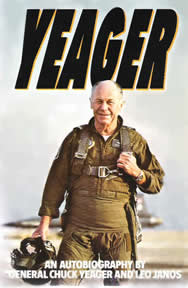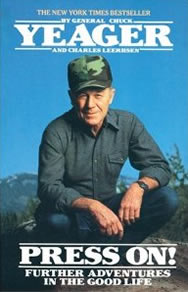For millions of people around the world, General Chuck Yeager is the man who best epitomizes the unique blend of qualities that writer Tom Wolfe captured in the title of his 1979 best seller, The Right Stuff. For Wolfe, Yeager stood at the apex of “the ziggurat pyramid of flying" and was “the most righteous of all the possessors of the right stuff.”
While Wolfe’s book may have made Chuck Yeager a household name, his knowledge of the man came second hand. He had never witnessed any of his exploits–never seen Yeager in action. And, when he wrote, he was looking back on a career that had already, long since, taken on mythic proportions. While his book is, in many ways, a masterful account of a bygone era, his depiction of those who comprised the flying “fraternity” Edwards in the early 50s is somewhat exaggerated. As General Yeager observed: “Tom got kind of emotional on the subject.”
The most reliable testimony on what made Chuck Yeager a legend within that fraternity comes from the men who actually knew him–the professionals who flew and worked with him. The most meaningful insights come from his peers.
Maj. Gen. Albert Boyd

Maj. Gen. Albert Boyd
As a Colonel and Chief of the Flight Test Division at Wright Field in the summer of 1947, Albert Boyd was confronted with a job of selecting the test pilot who would make the assault on the “sound barrier”. Considered “the father” of modern USAF flight testing, General Boyd recalled several years later:
“Selecting the X-1 pilot was one of the most difficult decisions of my life. If the pilot had an accident, he could set back our supersonic program a couple of years . . . And I was well aware that the decision could be historic, so I asked my deputy, Col. Fred Ascani, to sit down with me and review all 125 pilots in the Flight Test Division and see what kind of list we could compile . . . I wanted a pilot capable of doing extremely precise, scientific flying. Above all, I wanted a pilot who was rock solid in stability. Yeager came up number one.
. . . there was no doubt in our minds that he was the one, because of his ability to perform and his stability and willingness to follow instructions, and, of course, his tremendous ability as a pilot . . . We had several other outstanding pilots to chose from but none of them could quite match his skill in a cockpit or his coolness under pressure.”
Maj. Gen. Fred J. Ascani
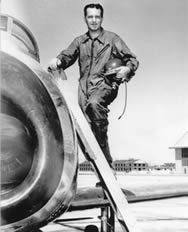
Maj. Gen. Fred J. Ascani
Col. Fred Ascani assisted Boyd in Yeager’s selection as the X-1 pilot and, over the next decade, he had a unique perspective from which to judge his abilities both as a test and fighter pilot. Yeager flew under his direction, as Ascani served as the first vice commander of the Air Force Flight Test Center here at Edwards in the early 50s and then as commander of the 50th Fighter Bomber Wing in Europe during the mid-50s. Throughout that period, he had many opportunities to fly with Yeager and observe his skill first-hand. Many years later, he observed:
“Yeager flies an airplane as if he is welded to it–as if he is an integral part of it. His “feel” for any strange airplane is instinctive, intuitive and as natural as if he had flown it for 100 or more hours . . . The fact that he was absolutely fearless in his pursuit of technical knowledge was an added plus. I never regretted my decision to concur in Col. Boyd’s selection of Yeager as the primary X-1 pilot . . . Many have theorized that several other test pilots could have achieved the same goals and, for some time, I thought the same. In retrospect, I candidly admit I am less sure of that opinion. One thought comes to my mind whenever I think of Yeager and that is: no one, earthbound or ethereal, will ever be a clone of Yeager. Never, ever.”
Lt. Col. Jackie L. Ridley
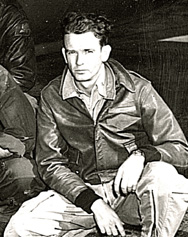
Lt. Col. Jackie L. Ridley
In 1947, Capt. Jack Ridley was assigned as the Air Force flight test engineer for the attempt to exceed the speed of sound in the X-1-and he continued to work closely with Yeager on a wide range of test programs until the mid-50s. A brilliant, Cal Tech-trained aeronautical engineer, he had the ability to translate arcane technical concepts into laymen’s terms that Yeager could easily understand. Like Dick Frost, he was impressed by Yeager’s uncanny ability to intuitively grasp complex engineering concepts: “He never studied engineering, but he blots the stuff up as fast as it’s poured.”
Chuck Yeager about Jack Ridley: “Hoover and I were definitely not flight test engineers! We could fly airplanes and we had an instinct for aerodynamics… but Jack Ridley was a brain! Jack Ridley knew everything there was to know about aerodynamics and he was practical. And, besides, he was a good pilot and he fit right in with us. He spoke our language. Bob was a Tennessean and I was a West Virginian and, being an Okie, Jack spoke real good language for us. Even before we flew the X-1, I talked to him at great length about “what are we getting into? You know, what’s it mean? We’re going to be fooling around out of my real… and you may understand this stuff but I don’t. What the hell are we getting into?” And Jack would patiently explain. And I had a great deal of confidence in him and, you know, if he said something, that, to me, was from the Bible. You could take it to the bank.”
R.A. “Bob” Hoover

R.A. “Bob” Hoover
Over the past five decades, Bob Hoover has become an aviation legend, as he’s thrilled air show audiences around the world with his extraordinary aerobatic performances. In 1947, 1st Lt. Bob Hoover was a test pilot at Wright Field and one of the two finalists in the running to make the assault on the “sound barrier” in the Bell X-1. Chuck Yeager got the nod and Hoover was assigned as back-up and chase pilot for the program. He and Yeager have remained very close friends ever since. He recently recalled: “I felt about the program as Chuck did. I wanted to be the first to fly–to make that flight–and had hoped that I would have been. It wasn’t in the cards. And I can only say, and I’ve said this many, many times over the years, there never could have been anyone who could have done it better than my dear friend, Chuck Yeager.”
“I felt a great disservice had occurred when they clamped the security and secrecy on it [the Mach 1 flight] because I had these strong feelings about Chuck and how great he was in the cockpit. I had never met or known anyone who could fly as well as he did. And, to see this suppressed, and for him not to get the recognition until so long after the fact, . . . I mean, sure, word got out a little bit, but he really didn’t get the recognition ’til many years later.”
Richard H. “Dick” Frost
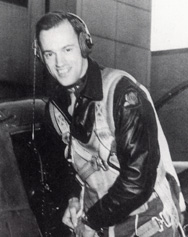
Richard H. “Dick” Frost
Dick Frost was Bell’s chief flight test engineer on the X-1 program. In addition to his other duties–such as flying chase for all of the rocket plane’s launches, it was his job to teach Yeager everything he knew about the airplane and its systems. A distinguished aviation pioneer in his own right (he was awarded a “Laurel” for lifetime achievement by Aviation Week & Space Technology in 1996), Frost was an objective–and remarkably astute–observer of Yeager’s performance in the cockpit:
“Charlie Yeager is completely nerveless . . . He’s the coolest guy I’ve even seen, and it’s been my business to see a lot of pilots preparing for flights of doubtful outcome. I had been a test pilot and I had worked with some of the best in the business but there was something special about Chuck that immediately set him apart from the rest. There’s no doubt that he was an outstanding pilot–and then some! All you had to do was watch him fly to know that here was a pilot who flew almost as though he was a part of the airplane. Still, I had known a good many stick-and-rudder men. What really set Chuck apart was his unquenchable thirst for knowledge. He wanted to learn everything he possibly could about the airplane and its systems. He asked absolutely all of the right questions and even a few I hadn’t thought of. He wasn’t a trained engineer but he quickly grasped and mastered the most technical concepts and he skillfully put that knowledge to work once he got in the cockpit.”
Bill Bridgeman
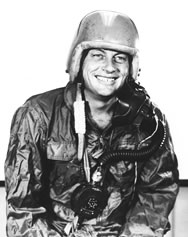
Bill Bridgeman
When Douglas test pilot Bill Bridgeman first arrived at Edwards in 1950, he learned that Yeager was “number one on base” and he’d “worn his crown securely.” It didn’t take him long to find out why.
On the first mission Yeager flew chase for him, he was flying a D-558-II Skyrocket configured with both a jet and a rocket engine. While climbing a rocket-ignition altitude on jet power, he was blinded by the glare on the sun. As Bridgeman recalled the episode in his autobiography:
“Now, now.” Yeager playfully reprimands. And outside the slit windowpane I see the chase plane glued to my wing. I had forgotten about Mr. Supersonic. The sun is directly in my eyes. I can’t get a good look at him but he is close enough to shake hands with. I squint in his direction trying to make him out.
My eyes take a second to become adjusted to the shadowy cockpit again. It’s difficult to read the instruments with the sun burning in my eyes. I am startled as a shadow falls, unexpectedly, across my face, blocking the glare out of the cockpit. Slightly ahead and above me, Yeager is dipping his wing in front of the sun, shading my eyes.
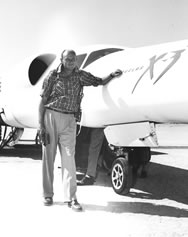
Bill Bridgeman
“Is that better, son?”
“Yeah.” And, for a minute, I’m without retort–the captain’s reputation is not exaggerated.
“Would you mind scratching my back with your other wing?” He flies! The bastard.
He has made his point and he couldn’t have picked a worse time, but his cool, brilliant piece of horseplay eases the tension and I laugh. This is quite a boy. He continues to hold his position, blocking the sun out of my eyes until I have turned out of its glare.”
On at least three subsequent flights, Bridgeman joined the ranks of those who owed their lives to Yeager’s skill as a chase pilot.
Brig. Gen. Frank K. “Pete” Everest

Brig. Gen. Frank K. “Pete” Everest
Then-Lt. Pete Everest was known as “the fastest man alive” in the mid-50s. In 1953, he set a world absolute speed record of 755 mph in the YF-100 (the last record at low altitude) and, in 1956, he piloted the X-2 rocket plane to a speed of Mach 2.87 (1900 mph). As chief of flight test operations at Edwards throughout the early 50s, he flew most of the exotic X-Planes of that era. He gave Yeager the credit for providing him with that opportunity because, prior to his flights in the X-1, military test pilots had been relegated to a second-class status. They were not given the opportunity to engage in experimental research flying. Thus Everest contended that there was a lot at stake when Yeager climbed into the cockpit of the X-1 on 14 October 1947:
“The future of military flight testing was riding with him that morning in the little X-1. Colonel Boyd, who supervised the project, was aware that many people felt we were too inexperienced for the assignment, one which no civilian pilot had yet accomplished. Had Yeager failed, it would have confirmed the warnings of our worst critics . . . But Chuck’s successful flight did much more than silence criticism. It opened the way for the military test pilot to accept more responsibility and participate as an equal in the future development of aviation.”
Bob Rahn
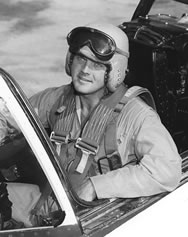
Bob Rahn
Though there was an ongoing rivalry between Air Force and contractor test pilots at Edwards throughout the early 1950s, legendary Douglas test pilot, Bob Rahn, had to give Yeager his due:
“Chuck Yeager flew chase on me during one of my early flights in the Skyray. As was his habit, he flew awfully tight formation. I was endeavoring to determine what was causing some low-amplitude lateral oscillations, and he was so close to my plane that he could read the instruments in my cockpit. I didn’t want him that near because I couldn’t safely make any control inputs while investigating the lateral oscillations.
“You’re too close,” I transmitted. “I don’t know what this plane might do and I don’t want a mid-air collision. Please, move it out.”
Reluctantly, he backed off. In fairness to Yeager, he was a superb pilot but, equally important, he had an insatiable interest in how other airplanes flew, what their characteristics were, how they behaved in the sky. This attribute certainly enhanced his reputation as a master pilot.”
Maj. Gen. Joe Engle
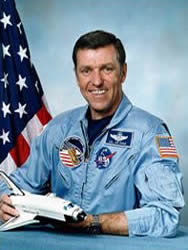
Maj. Gen. Joe Engle
Joe Engle has known–and flown with–Yeager for more than four decades. They first met at George AFB back in the late 50s when Yeager was commanding the 1st Fighter Day Squadron and Engle was a young lieutenant flying for the 474th Fighter Day Squadron. Yeager taught him a few “lessons” about fighter tactics. Even though Yeager “waxed his fanny”, he was extremely impressed by the young fighter pilot’s abilities and he subsequently sponsored his admission into the USAF Test Pilot School and then astronaut training in the USAF Aerospace Research Pilot School. Joe Engle went on to become the only person to fly into space in two different winged vehicles–the X-15 and the Space Shuttle–and he remains the only astronaut ever to manually fly a complete reentry profile from orbit at Mach 25 through landing rollout. He considers general Yeager both a close friend and mentor:
“For nearly a half century, General Yeager has been my role model, inspiration, tutor, comrade fighter/test pilot-in-arms, military commander, and most valued personal friend. Few people have a reputation like General Yeager’s to live up to. Fewer still are able to live up to that reputation. I am extremely fortunate in that my career path has allowed me to fly and serve with General Yeager for a span of 40 years . . . This has given me a unique opportunity to learn from a master . . . Chuck Yeager doesn’t just fly an airplaneâ–any airplane–better than anyone else I have ever known, or ever will know. Chuck Yeager communicates with the airplane, and then he is able to relate to his conversation and priceless information–much of it absolutely unobtainable with even the most advanced and sophisticated instrumentation–to the engineers and other pilots.”
Col. David R. Scott
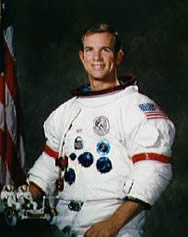
Col. David R. Scott
David Scott was one of Gen. Yeager’s students at the Aerospace Research Pilot School. As a NASA Astronaut, he was pilot on Gemini VIII, Command Module Pilot on Apollo IX, and Commander of Apollo 15. In 2009, Col. Scott received the Brig. Gen. Charles E. Yeager Aeronautical Achievements Award, presented by Gen. Yeager (via video). Here’s what Col. Scott had to say about the importance of his mentors like Gen. Yeager (Bonus: Watch the video presentation).
“This is really a meaningful honor to me. I know Chuck pretty well and… as you go through your career you have mentors along the way who guide you and teach you things, and I was lucky all the way through my career. My dad was a fighter pilot. I wanted to be a fighter pilot. I went to flying school and my instructor was an old barnstormer who had red hair, red mustache, and ruddy face. His name was Chauncey P. Login and he taught me how to fly.”
“I then got in a fighter’s squadron and my squadron commander was a double Ace from Korea, Boots Blesse who wrote the book “No Guts No Glory”. And then… after 4 years of fighters in Europe, I went to grad school for a couple of years and I didn’t get to do much flying, but after that I reported into Edwards to go to the Test Pilot School…

Col. David R. Scott
I got there a little early because I wanted to get a little flying time… So I was just hanging around base ops looking for any kind of ride and somebody called up and said “hey Col. Yeager needs somebody to take him to Holloman, New Mexico – are you willing” I said “you bet!” I thought, Col. Yeager? I’m a little captain you know. I am just checking into the test pilot school and here is Ch…Chuck Yeager! So fine. I go out and fill out the flight plan and he shows up. He says “Hey Dave I’ll take it over and you bring us back.” I said “yes sir, fine!”
So we go over there and I am supposed to meet him at base ops at 10:00 in the morning and I have done all my paperwork and I have checked the airplane. It’s a Colonel, you know, and I am just a Captain… I am going to do everything exactly right and I didn’t really know him very well at the time. So we get in the airplane. I am in the front seat and he is in the back seat and he says “OK let’s go”.
“So rolling down the runaway, boy, I am right on every air speed just doing everything exactly right. And I ease the nose up and all of the sudden from the back seat comes “pull it up”. I thought oh geez. So I pulled it up … we are in a T38 and it’s a pretty hot little airplane. He said “pull it up, come on pull it up!”… So I pulled that sucker as steep as I could make it. He says “OK let’s have a look, roll her over”. Pitched over and there were his buddies on the ground. I thought that’s my kind of guy! So I am really honored to receive this from a good friend, a true mentor and somebody for whom I have the greatest respect and admiration, General Chuck Yeager.”
Col. Jack Oliver
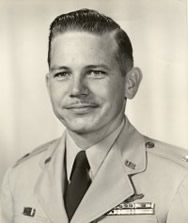
Col. Jack Oliver
I was the Base Adjutant at Albrook Field in the Canal Zone 52-55, when our fledgling Air Force decided to host a Central and South American “Good Will” tour centered around the Thunderbird Team of F-86’s and Chuck Yeager, who was the renowned test pilot who had exceeded the speed of sound and had many other aeronautical accomplishments.
The Carribean Air Command/Albrook Field were to be on-site hosts for the tour. All of the staff that could be spared were assigned duties, as well as to be escorts to each of the tour’s dignataries.
I was assigned to Chuck Yeager to answer his beck and call, since I had been in the 1st Fighter Wing and had flown the P-51 and the P-80. We got along just fine–except that you didn’t carry Chuck Yeager’s bag or anything else; you just accompanied him and enjoyed his company.
He was one neat guy that you could never get ahead of. He was always up, out and gone before your feet hit the floor. The more I tried to help him, the less I could do. If you were in a group of people with him, he had the knack of making each and every person feel only they were getting his complete attention. Chuck flew the F-86 at each show in every capitol. What a fantastic flier!
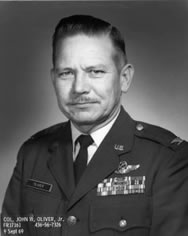
Col. Jack Oliver
I did not see him again for nearly ten years, until late one night when I was on a cross-country in a T-Bird out of Vandenberg AFB.
I stopped at Albuquerque to refuel and see my old Base Commander from Albrook, Col. Joe Martin, who was the Sandia Base Commander. We were sitting on the tailgate of his old pickup when the AO came running out exclaiming “Colonel, we’ve got a flameout in a T-33 forty miles east. The pilot said he wanted no emergency support, that he would call on final, and that he was turning everything off to save his battery.” The AO went on to say that the pilot quickly gave his plane number and his name before signing off, saying “pilot and sole occupant is Chuck Yeager.”
The AO asked Joe Martin if he should get a fire truck and Air Police out there, but Joe said “No, have them stand by”.
Several minutes later, landing lights flashed about 1/2 mile out on final approach, then went out. That AO was anxious but Joe Martin just told him to relax. It wasn’t long until we heard the tires squeek as they touched the runway. A moment later that T-Bird turned off at the center taxi-way, rolled up to within 20 feet of our pickup tailgate where we were sitting, tapped the brakes slightly to bow the nose, and the canopy raised.
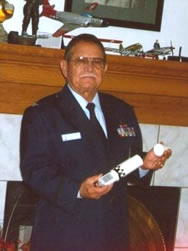
Col. Jack Oliver
Chuck Yeager had just dead-sticked that T-33 some 40-odd miles and then rolled right up to our pickup, and did this all at midnight in pitch-black darkness, over mountains! But that was not all.
The first thing he said to us was “Joe Martin and Jack Oliver, what a welcoming party! I don’t think I’ve seen either of you since South America on The Good Will Tour”.
Now, we all know of the thousands of people he had met on that tour–and so many more people since–yet he remembered not only our last names but our first names as well.
What a fantastic person! What a privilege to have known this fine and wonderful man, and to have been able to do something for him when he has done so much for so many. In my thirty years in the Air Force, and near many ranking officers, I have never met a person that I admired and respected more than Chuck Yeager. I’m certain most everyone has heard of Chuck Yeager’s keen wit, his cleverness, his power to reason, and a memory we all wish we had, but I was priviledged to experience it first-hand.
Published Sources for Additional Reading
YEAGER: An Autobiography
by Gen. Chuck Yeager and Leo Janoc
People who know nothing else about aviation know that it was Chuck Yeager who broke the sound barrier.
Those who have read Tom Wolfe’s The Right Stuff also know he did it with broken ribs from a nocturnal horse race.
Readers of this engrossing work will find these circumstances typical of the way Yeager has always done things.
In matter-of-fact language that covers both suspenseful flying descriptions and high times with drunken flying buddies, Yeager holds one’s attention with the same ease that he brought to research and test flying.
There is understatement in his descriptions of combat flying over Europe, of family life and his displeasure over having to be gone so long, of the years in the California desert; and his confident tone enhances these and other reminiscences in what has to be the aviation literature event of the year, and a bonus for general readers, too.
(Review by Mel D. Lane, Sacramento, Cal., for Library Journal. Copyright 1985 Reed Business Information, Inc.)
PRESS ON! Further Adventures In The Good Life
by Gen. Chuck Yeager and Charles Leerhsen
Carrying on in the style of Yeager, an Autobiography, the General regales readers with entertaining tales of his post-military adventures, his home life, and, most of all, his love of the outdoors.
The philosophy (expressed in the title) and personal makeup of that younger fighter pilot are evident.
The remainder of the book is a description of his daily life, coping with what he wryly calls “the hero business” and what he sees as his obligation to his public.
Yeager never heard of “the right stuff” before Tom Wolfe coined the term, but if personal style and confidence are part of that “stuff,” Yeager certainly has it.
(Review by Mel D. Lane, Sacramento, Cal., for Library Journal. Copyright 1988 Reed Business Information, Inc.)
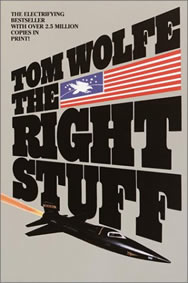
The Right Stuff, by Tom Wolfe
THE RIGHT STUFF
by Tom Wolfe
“Technically accurate, learned, cheeky, risky, touching, tough, compassionate, nostalgic, worshipful, jingoistic . . . The Right Stuff is superb.” (The New York Times Book Review)
“One of the most romantic and thrilling books ever written about men who put themselves in peril.” (The Boston Globe)
“Absolutely first class . . . Improbable as some of Wolfe’s tales seem, I know he’s telling it like it was.” (The Washington Post Book World)
“Crammed with inside poop and racy incident . . . fast cars, booze, astro groupies, the envies and injuries of the military caste system . . . Wolfe lays it all out in brilliantly staged Op Lit scenes.” (Time)
“Splendid . . . It shows our propensity to manufacture heroes, and, just as quickly, to forget them; it shows how a scientific program was exploited for political advantage; it provides a revealing character study of seven exceptional Americans.” (The Saturday Review)

